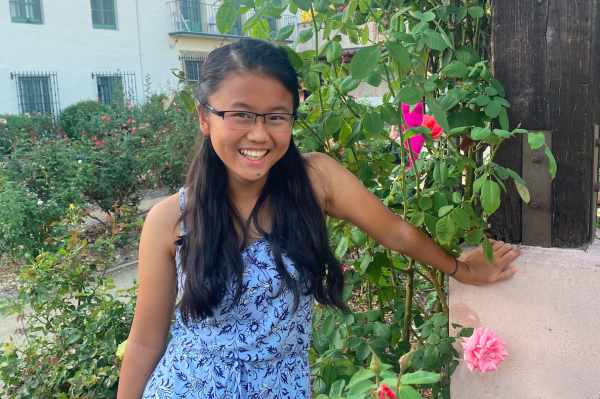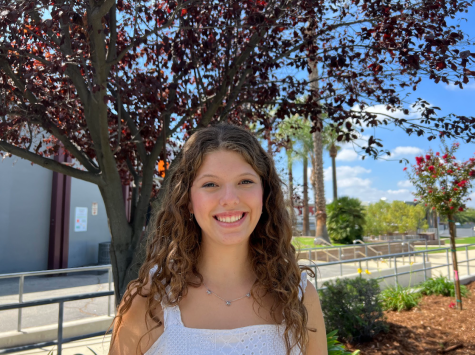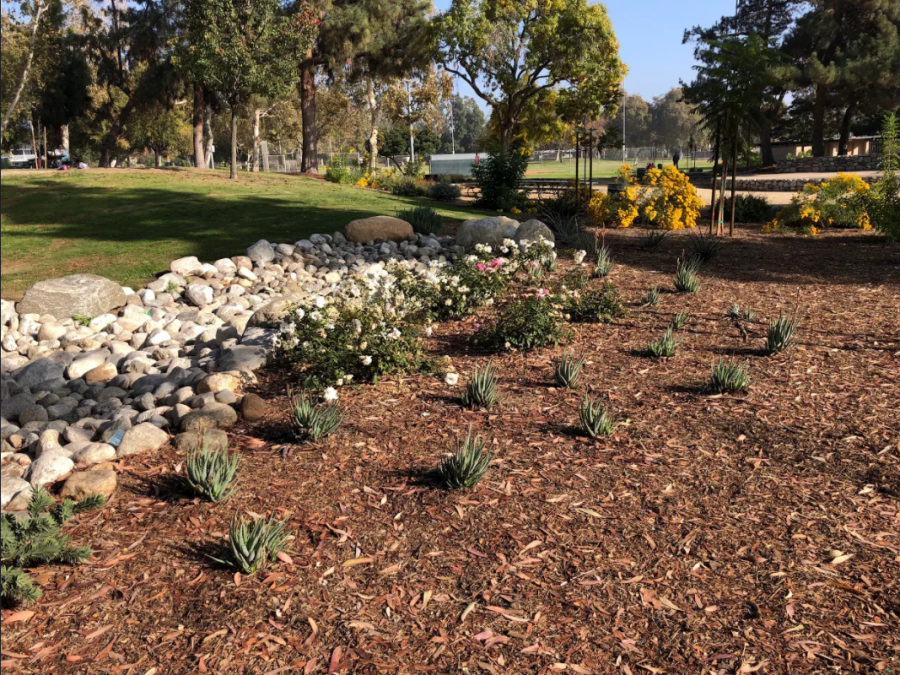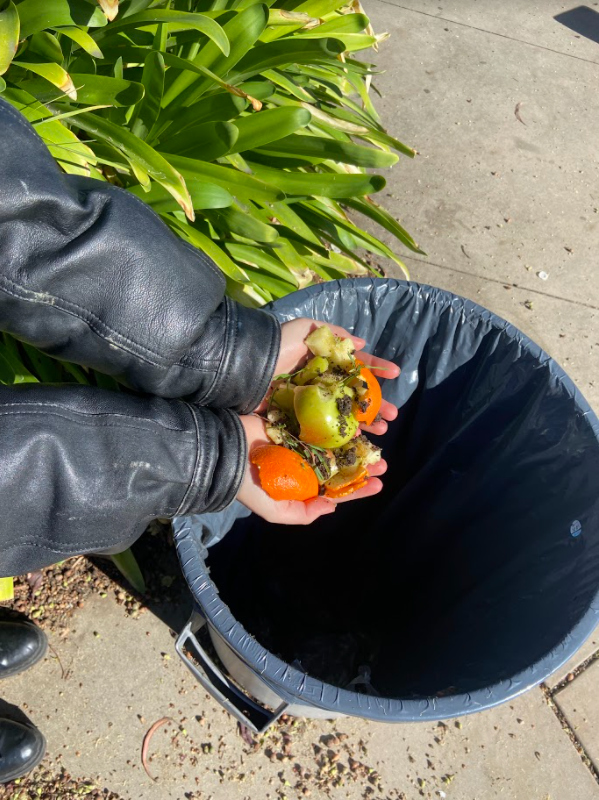Keen to go green: Claremont stops talking trash and starts talking compost & water
Cahuilla Park (next to Claremont High School) after city turf reduction.
In the wake of climate change, with food piling up in landfills and droughts descending across the land, the City of Claremont has put into place new measures to be more sustainable. Measures for saving water and slowing landfill have affected residents and high schoolers alike. In this time of upheaval, the City has not forgotten about the need to be green — or in this case, brown.
Passing by Cahuilla Park while going to school, one notices that there are fewer green, grassy spaces than there used to be a year ago. Some of the lawn is gone, and rocks, mulch, shrubs, and cacti are in its place.
California has entered another state of drought, and conditions have worsened. In an attempt to conserve water and money, the city of Claremont elected to remove sections of the turf at Cahuilla Park. The City had a proposal to do so more than a year ago, but their first notification that this was actually scheduled to happen on March 10th, 2021.
The City of Claremont website stated in the March news post that “Community Services staff and Excel Landscape have worked together to create a design incorporating elements to reduce water usage, including drought-resistant plants, a drip irrigation system, and a storm water retention feature. Approximately 48,000 sq. ft. of turf will be converted under this project.”
In other words, the amount of space that has been and will be turned from grass to mulch-based sustainable landscape in a process known as turf reduction. This will result in an area of mulch and plant life covering over 80% of the CHS football field. The city worked on this project at Cahuilla Park over the summer.
One of the biggest changes that has been implemented in this project is the installation of the new drip irrigation system. Unlike sprinklers, which spray water everywhere, a drip irrigation system is much more precise and controlled. Sprinklers often shower and waste water on the sidewalk, while the drip system gives water directly to the plants.
Mrs. Maureen Safely, one of the proctors around CHS, remarked on how useful the new water system is.
“I think it’s great,” Safely said. “We’re in a drought right now. We have to cut back on water usage, and that’s up to all of us. It’s the elixir of life, for plant life, animal life, and human life. We all need water.”
The plants that the city planted in the new area are drought-resistant, meaning that they do not need much water to survive. Two examples of the plants they planted are white roses and aloe. White roses do not need much water, as they are very hardy. Similarly, aloe vera only needs water every other week.
Senior Mercer Weis is the club leader for Voices for Change, an environmental club on campus, and believes that water conservation is vital for the environment.
“Water conservation is pivotal for improving the drought we are experiencing in California,” Weis said. “Many climate disasters, such as wildfires and desertification, are rooted in the fact that water is not being conserved properly. I always try my best to reduce my intake of water by limiting my consumption of red meat as well as avoiding corporate businesses that mass produce.”
Corporate businesses use gallons of water per dollar output, which is why Weis avoids them. Senior Viraj Urkudey also has his thoughts on the need for water conservation.
“It is extremely important that we conserve water as it is a valuable resource that we have a very limited supply of,” Urkudey said. “Although we obviously have the ocean, the process to remove the salt is extremely expensive and takes up a lot of energy.”
Urkudey also sits at the park for lunch, using his off-campus pass, and notices how over the years he has been at CHS the park environment changed.
“The grass has gotten dehydrated, browner, and more dead throughout the years, unfortunately because it’s a pretty park too. I feel like I’ve seen less animals, kind of. I’d always see squirrels and other animals there.”
Saving water in this time of drought is essential, especially considering it is already December and there has been little to no rain this fall. The turf reduction at Cahuilla Park is an important step towards combating this crisis by allowing Claremont to conserve the valuable water it has.
In further steps to improve sustainability in Claremont, the city has announced a new composting program. Starting this upcoming new year, this program mandates that residents take their leftovers and place them into the compost bin, rather than the trash. According to the City of Claremont’s website, recycling organic waste products can have a significant impact on limiting Methane emissions.
“The new requirements are part of a statewide effort to reduce harmful methane emissions. Recycling organic waste is a small change with big environmental benefits. Composting food scraps and green waste reduces the amount of waste that is taken to landfills, a major source of methane emissions. If everyone in the United States composted their food waste, the impact would be equivalent to removing 7.8 million cars from the road.”
When the new mandate starts on January 1, 2022, residents will be expected to place their compost bin contents into the green bin before trash pickup. Before then, the City has tips to help residents with Organic Recycling:
– Use a reusable container with a tight-fitting lid to collect food scraps in your kitchen. Empty your food waste container into the green barrel every few days.
– Wash your kitchen container frequently with hot water and detergent. Layer food waste between layers of green waste to help keep your container tidy.
– Chill it! Put leftovers in a container and keep them in your refrigerator or freezer until close to collection day.
Curbside recycling began here in Claremont in 1983, years before most other cities even considered providing collection of recyclable materials. So it only feels right that Claremont is one of the first in taking this next step to help the environment.
With these new ideas to help the city, the environment, and the planet, one can only conclude that these measures are a step towards the bright, green future.
Hello there! Our goal is to provide relavent, engaging journalism for readers of all ages. Your donation will support the student journalists of the Wolfpacket at Claremont High School, and will allow us to purchase equipment, print our monthly issues, and enter in journalism competitions. We appreciate your consideration!

Mayo Ou is the Head Editor-in-Chief of the Wolfpacket and a senior at CHS in her fourth year on the staff. Her goal this year, other than not procrastinating...

Jack Warren is editor-in-chief of The Wolfpacket and a senior at CHS. As an avid rock climber, he can be found at the Upland Hanger around three times...

Melina Tisopulos is a senior and the Editor-in-Chief of The Wolfpacket. Melina loves to write and intends on studying journalism or English in college....












